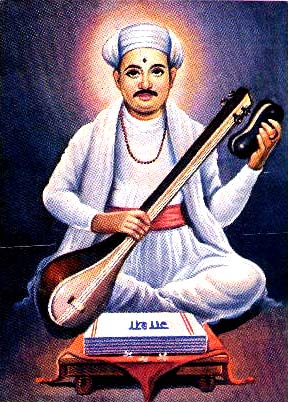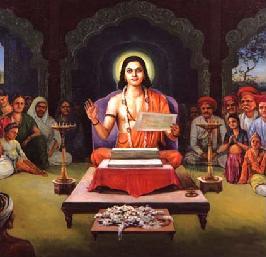In a letter dated July 30, 1977, Srila Prabhupada encouraged H.H Lokanath Maharaj in this way: “The whole of India and specifically your Maharashtra are enthused with Krishna. Now you have to revive their Krishna consciousness. This is Tukarama’s country, but now they are becoming bad politicians. So revive them by the process of the sankirtana movement.”

Saint Tukarama
Saint Tukarama was the most famous of all Maharashtrian saints. He lived during the seventeenth century, and over the last three hundred years his devotional influence has been deeply felt by the local people. His poems, the 4,500 verses known as the Abhangas, have become part of the public memory of Maharashtra. They are sung in every village and every home.
Tukarama preached throughout his life, exhorting his countrymen to take to the path of bhakti, devotional service. His language was so simple and down to earth that even the most simple villagers understood it completely. He is the main force behind the continuous kirtanas and bhajanas performed at the many festivals in Pandharpur.
In his autobiography, Tukarama says he was initiated in a dream by Raghava Caitanya Kesava Caitanya. Though not everyone agrees, Gaudiya Vaisnavas (such as the ISKCON devotees) understand this to mean Sri Caitanya Mahaprabhu.
As Srila Prabhupada comments (Caitanya-caritamrta, Madhya 9.282, purport), “The sankirtana party belonging to Tukarama is still very popular in Bombay. [It] exactly resembles the Gaudiya Vaisnava sankirtana parties, for they chant the holy name with mrdanga and karatalas.” They also wear neck beads and tilaka similar to those of the Gaudiya tradition.
Tukarama Acarya was a great devotee of Lord Vitthala. As mentioned before, the Deity is self-manifested. That is, He spontaneously appeared, without being carved and installed. Expressing full faith in this Deity of Lord Vitthala, Tukarama wrote, “If anyone says that this Deity was once installed, his mouth will be filled with worms.”
Saint Tukarama sometimes had to suffer humiliation and opposition from envious people, but he always stayed more humble than a blade of grass, thus changing the hearts of his enemies. The saint left for the spiritual world in his selfsame body while engaged in nama sankirtana, chanting of the holy names of the Lord, with the residents of his home village. The villagers attested they saw a spiritual airplane descend and saw Tukarama board the plane and leave for the spiritual sky.

Saint Gyaneshwar
Another exalted spiritual leader among Lord Vitthala’s devotees was Jnanesvara, who lived in the thirteenth century. At the age of sixteen, he translated the complete text of Bhagavad-gita into simple Marathi, the language of Maharashtra. His work is known as Jnanesvari. He attained samadhi (passed away) at the age of twenty-one.
Also famous is the life of Saint Namadeva. Once when Namadeva was a young boy, his father, who worshiped a Deity of Lord Vitthala at home, went out, leaving Namadeva in charge of the Deity. When the time came to offer food to the Lord, Namadeva prepared a plate, placed it on the altar, and sat down, begging the Lord to accept the offering. Following his father’s advice to give the Lord some time to eat before taking back the plate, Namadeva left the Deity room and patiently waited, expecting the Lord to literally eat up the food. From time to time the boy would check, but the Lord seemed to be standing still.
After quite some time had passed and Namadeva saw no sign that the Lord would ever eat, Namadeva decided to intervene. Entering the Deity room, he appealed to Lord Vitthala, insisting that the Lord eat right away. And if He wouldn’t, the boy threatened, he would smash his own head against the wall. To the boy’s surprise, Lord Vitthala then took His lotus hands off His hips and physically ate the offering.

Saint Namadeva